Tarot of Marseilles
| Tarot de Marseille | |
 The Hermit or L'Hermite Major Arcanum from the early 18th century Tarot of Jean Dodal | |
| Style of Card : | Tarot |
|---|---|
| Origin: | Marseille |
| Designer: | Anonymous; traditional |
| Purpose: | Recreation and Divination |
| Structure: | 22 Trumps or Major Arcana
56 Suits or Minor Arcana |
| Suits: | Bâtons (Rods, Sceptres, Wands)
Épées (Swords) Coupes (Cups) Deniers (Coins) |
The Tarot of Marseilles or Tarot of Marseille, also widely known by the French designation Tarot de Marseille, is one of the standard patterns for the design of tarot cards. It is a pattern from which many subsequent tarot decks derive.
Origins
Michael Dummett's research led him to conclude that (based on the lack of earlier documentary evidence) the Tarot deck was probably invented in northern Italy in the 15th century and introduced into southern France when the French conquered Milan and the Piedmont in 1499. The antecedents of the Tarot de Marseille would then have been introduced into southern France at around that time. The game of Tarot died out in Italy but survived in France and Switzerland. When the game was reintroduced into northern Italy, the Marseilles designs of the cards were also reintroduced to that region.
The recent documentary "Les mystères du Tarot de Marseille" (Arte, 18 dévrier 2015) claims that the work of Marsilio Ficino can be credited as having inspired imagery specific to the Marseilles.
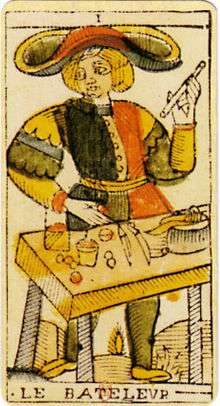
Etymology
The name Tarot de Marseille is not of particularly ancient vintage; it was coined at least as early as 1889 by the French occultist Papus (Gérard Encausse) in Chapter XI of his book le Tarot des bohémiens (Tarot of the Bohemians), and was popularized in the 1930s by the French cartomancer Paul Marteau, who used this collective name to refer to a variety of closely related designs that were being made in the city of Marseille in the south of France, a city that was a centre of playing card manufacture, and were (in earlier, contemporaneous, and later times) also made in other cities in France. The Tarot de Marseille is one of the standards from which many tarot decks of the 19th century and later are derived.
Structure
Like other Tarot decks, the Tarot de Marseille contains fifty-six cards in the four standard Suits. In French-language versions of the Tarot de Marseille, those suits are identified by their French names of Bâtons (Rods, Staves, Sceptres, or Wands), Épées (Swords), Coupes (Cups), and Deniers (Coins). These count from Ace to 10.
As well, there are four court cards in each suit: a Valet (Knave or Page), Chevalier or Cavalier (Horse-rider or Knight), Dame (Queen) and Roi (King). Occultists (and many tarot readers nowadays, whether English- or French-speaking) call this series the Minor Arcana (or Arcanes Mineures, in French). The court cards are sometimes called Les Honneurs (The Honors) or Les Lames Mineures de Figures (The Minor Figure Cards) in French, and the "Royal Arcana" in English.
In the Tarot de Marseille, as is standard among Italian suited playing cards, the pip cards in the suit of swords are drawn as abstract symbols in curved lines, forming a shape reminiscent of a mandorla. On the even numbered cards, the abstract curved lines are all that is present. On the odd numbered cards, a single fully rendered sword is rendered inside the abstract designs. The suit of wands is drawn as straight objects that cross to form a lattice in the higher numbers; on odd numbered wands cards, a single vertical wand runs through the middle of the lattice. On the tens of both swords and batons, two fully rendered objects appear imposed on the abstract designs.[1] The straight lined wands and the curved swords continue the tradition of Mamluk playing cards, in which the swords represented scimitars and the wands polo mallets.[2]
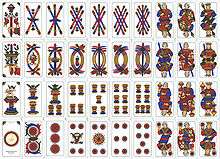
In this abstraction, the Tarot, and the Italian playing card tradition, diverges from that of Spanish playing cards, in which swords and batons are drawn as distinct objects. Cups and coins are drawn as distinct objects. Most decks fill up blank areas of the cards with floral decorations. The two of cups typically contains a floral caduceus-like symbol terminating in two heraldic dolphin heads. The two of coins usually joins the two coins by a ribbon motif; the ribbon is a conventional place for the manufacturer to include his name and the date.[3]
There are also the standard twenty-two trump cards. At times, the Fool, which is unnumbered in the Tarot de Marseille, is viewed as separate and additional to the other twenty-one numbered trumps. Occultists (and many tarotists nowadays) call these twenty-two cards the Atouts (trumps), Les Lames Majeures de Figures (The Major Figure Cards) or Arcanes Majeures (major arcana) in French.
|
I. Le Bateleur (The Mountebank, The Juggler, The Magician) |
XII. Le Pendu (The Hanged Man) |

(The Papess or High Priestess Tarot), the subject of much controversy
Variants
The use of obviously Christian traditional images (such as the Pope, the Devil, the Grim Reaper and the Last Judgement) and indeed controversial Christian images such as La Papesse — often thought to represent the legendary Pope Joan — have spawned controversies from the Renaissance to the present.
Papess controversy
The Papess card has sparked controversy because of its portrayal of a female pope. There is no solid historical evidence of a female pope, but this card may be based around the mythical Pope Joan. Many variant names have been used to avoid such controversy, including Juno, The Spanish Captain and The High Priestess.
One variant of the Tarot de Marseille, now called the Swiss Tarot or the Tarot of Besançon, removes the controversial Papess and Pope and, in their stead, puts Juno with her peacock, and Jupiter with his eagle. More recent decks, following a suggestion by Court de Gébelin, often rename the Papess as the "High Priestess", and the Pope as the "Hierophant" (Greek > "High Priest"). During the French Revolution, the Emperor and Empress cards became the subject of similar controversies and were displaced by Grandfather and Grandmother.
Just as to the east of the French centre is the Besançon/Swiss Junon-Jupiter (II-V) variant, so to the north are variants in the Flemish decks. The Papesse is replaced with Le 'Spagnol Capitano Eracasse (Italian > the 'Spanish Captain' Fracasso, a stock character from Commedia dell'arte). The Pope. often depicted holding an orb or a covered communion chalice, is replaced by Bacus (Bacchus, the Greek god of wine) holding a wine cup or bottle and a fruited vine cane or bunch of grapes while astride a beer barrel or wine cask.

Thirteenth trump card
The XIII card is generally left unnamed in the various old and modern versions of the Tarot de Marseille, but it is worth noting that in the Noblet Tarot de Marseille (circa 1650), the card was named LAMORT (Death). In at least some printings of the French/English bilingual version of the Grimaud Tarot de Marseille, the XIII card is named "La Mort" in French and named "Death" in English. In many modern tarot decks (e.g., Rider-Waite-Smith), the XIII card is named Death. In at least one 19th-century Italian tarot deck (e.g., the one photoreproduced by Italian publisher Lo Scarabeo as the "Ancient Italian Tarots" deck), the card is named "IL TREDICI" (Italian > "Thirteen").
Depictions
The Valet de Bâtons (French > "Page of Batons") is another card worth noting in this regard. In the Tarot de Marseille, the title of that card generally appears on the side of the card, while in some old versions of the Tarot de Marseille that card, along with either some or all others, is left unnamed.

In the Flemish decks there are certain peculiarities as well. The Hanged Man is shown still pendant but right-side up. Temperance bears the motto FAMA SOL (Latin > "The Rumored or Omened Day") in a scroll, probably counseling patience until the day of their deliverance from Spain. The Tower is renamed La Foudre (French > "The Lightning"), and shows a man sitting beneath a tree being struck by lightning. The Star is unnamed, but is often called "The Astronomer" or "The Navigator", and shows a man with compasses staring up at the sky next to a tower. The Moon shows a woman holding a distaff and The Sun shows a man on horseback bearing a banner. The World depicts a naked woman atop a globe parted into a moon in a starry sky and a sun in a blue sky over a tower on land.
Later history
Each card, whether in the major arcana or minor arcana, was originally printed from a woodcut; the cards were later coloured either by hand or by the use of stencils. One well-known artisan producing tarot cards in the Tarot de Marseille style was Nicolas Conver, who produced one early attested deck in 1760. Other early attested decks in the Tarot de Marseille family of decks include Noblet's (circa 1650) and Dodal's (circa 1701). The chief use of the deck originally was to play the game of tarot, also known as tarock [German] or tarocco [Italian]; the use of tarot in divination is first attested in the 18th century in the journals of Giacomo Casanova.
It was the Conver deck, or a deck very similar to it, that came to the attention of Antoine Court de Gébelin in the late 18th century. Court de Gébelin's writings, which contained much by way of speculation as to the supposed Egyptian origin of the cards and their symbols, called the attention of occultists to tarot decks. As such, Conver's deck became the model for most subsequent esoteric decks, starting with the deck designed by Etteilla forward. Cartomancy with the Tarot was definitely being practised throughout France by the end of the 18th century; Alexis-Vincent-Charles Berbiguier reported an encounter with two "sibyls" who divined with Tarot cards in the last decade of the century at Avignon.
The Tarot of Marseilles in Piedmont
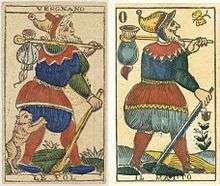
In the early eighteenth century the Marseilles Tarot was introduced in Northern Italy starting from the Kingdom of Sardinia, which also included the Savoy (now in France) and Piedmont, where the Tarot factories had entered into a deep crisis. The Piedmontese players did not have difficulties to accept the Marseilles Tarot, because the images were similar and even the French language captioning was widespread in many areas of Piedmont.
Around 1820 some manufacturers active in Turin, capital of the Kingdom of Sardinia, began to produce Tarot decks in Marseille's pattern, but after few years they introduced captions in Italian and small variations in certain figures. For example, the Fool was not chased by a wild animal but had a butterfly in front of him. In a few decades, variation after variation, was consolidated the iconography of the Piedmontese Tarot, which therefore must be considered as a derivation of the Tarot of Marseilles.[4]
Influence on French and English tarot design and usage
In the English-speaking world, where there is little or no tradition of using tarots as playing cards, tarot decks only became known through the efforts of occultists influenced by French tarotists such as Etteilla, and later, Eliphas Lévi. These occultists later produced esoteric decks that reflected their own ideas, and these decks were widely circulated in the anglophone world. Various esoteric decks such as the Rider-Waite-Colman Smith deck (conceived by A. E. Waite and rendered by Pamela Colman Smith), and the Thoth Tarot deck (conceived by Aleister Crowley and rendered by Lady Frieda Harris) -- and tarot decks inspired by those two decks—are most typically used. Waite, Colman Smith, Crowley and Harris were all former members of the influential, Victorian-era Hermetic Order of the Golden Dawn at different respective points in time; and the Golden Dawn, in turn, was influenced by Lévi and other French occult revivalists. Although there were various other respective influences (e.g., Etteilla's pip card meanings in the case of Waite/Colman Smith), Waite/Colman Smith's and Crowley/Harris' decks were greatly inspired by the Golden Dawn's member-use tarot deck and the Golden Dawn's tarot curriculum.
The Hermetic Order of the Golden Dawn was essentially the first in the Anglophone world to venture into esoteric tarot. Francophone occultists such as Court de Gebelin, Etteilla, Eliphas Lévi, Oswald Wirth and Papus were influential in fashioning esoteric tarot in the French-speaking world; the influence of these Francophone occultists has come to bear even on interpretation of the Tarot de Marseille cards themselves. Even though the Tarot de Marseille decks are not 'occult' "per se", the imagery of the Tarot de Marseille decks arguably shows Hermetic influences (e.g., alchemy, astronomy, etc.). Referring to the Tarot of the Bohemians, Eliphas Levi declares: "This book, which may be older than that of Enoch, has never been translated, but is still preserved unmutilated in primeval characters, on detached leaves, like the tablets of the ancients... It is, in truth, a monumental and extraordinary work, strong and simple as the architecture of the pyramids, and consequently enduring like those - a book which is the summary of all sciences, which can resolve all problems by its infinite combinations, which speaks by evoking thought, is the inspirer and moderator of all possible conceptions, and the masterpiece perhaps of the human mind. It is to be counted unquestionably among the very gret gifts bequeathed to us by antiquity..."[5]
In the French-speaking world, users of the tarot for divination and other esoteric purposes such as Alejandro Jodorowsky,[6] Kris Hadar, and many others, continue to use the Tarot de Marseille, although Oswald Wirth's Atouts-only (major-arcana) tarot deck has enjoyed such popularity in the 20th century (albeit less so than the Tarot de Marseille). In the mid-1990s Jodorowsky contacted a late descendent of the Camoin family, who has printed the Tarot of Marseilles since the 19th century. They worked together for almost a decade to put together a 78-card deck, including the original detail and 11 color printing.[6] Tarot decks from the English-speaking tradition (such as Rider-Waite-Colman Smith and decks based on it) are also gaining some popularity in French-speaking countries.
Paul Marteau pioneered the number-plus-suit-plus-design approach to interpreting the numbered minor arcana cards ['pip cards'] of the Tarot de Marseille. Prior to Marteau's book Le Tarot de Marseille (which was first published "circa" 1930s), cartomantic meanings (such as Etteilla's) were generally the only ones published for interpreting Marseille pip cards. Even nowadays, as evidenced by tarot readings of members of French-language tarot lists and forums on the Internet, many French tarotists employ only the major arcana cards for divination. In fact, in recognition of this, many French-language Tarot de Marseille tarot books (even good ones, such as Picard's) discuss the symbolism and interpretation of only the major arcana. Many fortune-tellers in France who use the "Tarot de Marseille" for readings will use only the major arcana and will use an Etteilla deck if they are to use all 78 cards for the reading.
Many of the images of the Rider-Waite-Colman Smith (RWS or WCS) deck are derived from the "Tarot de Marseille". However, the influence of other decks is also apparent in the RWCS deck, e.g., the 17th century Jacques Viéville deck for the Sun card and the 16th century Sola-Busca tarot deck for certain pip cards, notably the 3 of Swords and 7 of Swords. The 19th century deck of Swiss-French occultist Oswald Wirth was also influential for certain of the iconographic features of the Atouts or major arcana cards of the RWCS deck.
English translation and usage of the term 'Tarot de Marseille'
The term "Tarot de Marseille" has, in the past, most often been translated into English as "Tarot of Marseilles" because of the English spelling "Marseilles" for the city whose name in French is spelled "Marseille" (traditional English spellings for many famous geographical locations differ from the foreign spelling, e.g. 'Moscow' for 'Moskva' in Russia, 'Cologne' for 'Köln' in Germany; see Exonym). The spelling 'Marseille' is gradually enjoying greater, concurrent usage in the English language to describe the city generally; likewise, the alternate English translation "Tarot of Marseille" for the French term "Tarot de Marseille" is gradually increasing in usage.
Others have also tended to use the initials '"TdM"', allowing for ambiguity as to whether the 'M' stands for 'Marseille' or 'Milan', a region claimed for the origins of the image design.
In deference to the common appellation 'Marseille' for the style and in recognition that the deck appears in other places, the term '"Marseille-style"' is at times also used.
Major Arcana
The Major Arcana includes the Trumps and The Fool.
 Le Bateleur
Le Bateleur
(The Magician or The Juggler) La Papesse
La Papesse
(The Papess or The High Priestess) L'Impératrice
L'Impératrice
(The Empress) L'Empereur
L'Empereur
(The Emperor) Le Pape
Le Pape
(The Pope or The Hierophant) L'Amoureux
L'Amoureux
(The Lovers) Le Chariot
Le Chariot
(The Chariot)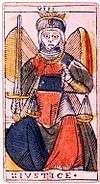 La Justice
La Justice
(Justice) L'Hermite
L'Hermite
(The Hermit) La Roue de Fortune
La Roue de Fortune
(The Wheel of Fortune) La Force
La Force
(Strength or Fortitude) Le Pendu
Le Pendu
(The Hanged Man) L'Arcane sans nom (La Mort)
L'Arcane sans nom (La Mort)
(The Mystery/Trump without name or Death) Tempérance
Tempérance
(Temperance)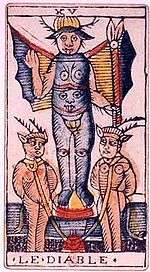 Le Diable
Le Diable
(The Devil) La Maison Dieu
La Maison Dieu
(The Tower or The House of God) L'Étoile
L'Étoile
(The Star)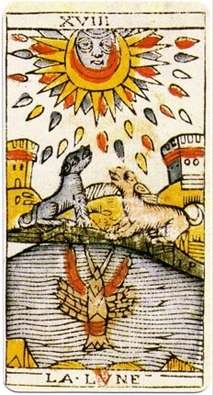 La Lune
La Lune
(The Moon) Le Soleil
Le Soleil
(The Sun) Le Jugement
Le Jugement
([The] Judgement) Le Monde
Le Monde
(The World) Le Fol (Le Mat)
Le Fol (Le Mat)
(The Fool)
The above Major Arcana images are from Jean Dodal's early 18th century version of the Tarot de Marseille.
Miscellaneous images
 The reverse of a Jean Dodal tarot card
The reverse of a Jean Dodal tarot card The Queen of cups
The Queen of cups The Knight of batons
The Knight of batons The two of cups showing the maker's name
The two of cups showing the maker's name
References
| Wikimedia Commons has media related to Tarot of Marseilles. |
Tarot decks
Various facsimiles of Conver's deck and other old decks are available. The Italian firm Lo Scarabeo prints a reproduction of an 18th-century deck by Nicholas Conver (with a re-constructed card missing from their original), mentioned above ISBN 0-7387-0014-2. The French firm Héron also publishes a photoreproduction of the complete Conver held in the Bibliothèque Nationale.
Others offer redrawn decks based on the old models. Grimaud is perhaps the best known such maker; their deck was designed by Paul Marteau, mentioned above. The Spanish firm Fournier prints an edition. Lo Scarabeo prints a version based on a 1751 Swiss deck by Claude Burdel, with an unwarranted alteration that sees a 'zero' added upon the Fou ISBN 0-7387-0011-8 (But see Stuart Kaplan, Encyclopedia of Tarot Vol. II, page 327, which shows a 1750 Swiss deck by Rochus Schär. The Schär deck's Le Mat card is numbered with a zero). U.S. Games / Cartamundi also printed a version based on the 1701 Dodal Tarot de Marseille, but that version has gone out of print.
Jean-Claude and Roxanne Flornoy[7] have also published a careful rendition of the Noblet and the Dodal decks.
In 1998, after four years of research, Alejandro Jodorowsky and Philippe Camoin published a restored version of the Tarot of Marseilles based on a study of all the oldest existing decks and wooden moulds (www.camoin.com). Also, Daniel Rodes and Encarna Sanchez have published a new edition called The anciens icons of tarot reconstructed about Marseille's Tarot.[8]
More recently, Igor Barzilai[9] has published a restoration of the Nicolas Conver tarot, hand-painted and using old paper techniques.
The Dodal deck held in the Bibliothèque Nationale has been photographically published by Dussere, but is now out of print.
Other publications
- The Game of Tarot by Michael Dummett ISBN 0-7156-1014-7 – a history of the Tarot, and a compilation of Tarot card games. (out of print)
- A Wicked Pack of Cards: The Origins of the Occult Tarot by Ronald Decker, Thierry Depaulis, and Michael Dummett ISBN 0-312-16294-4 – a history of the French origin of the occult Tarot, focusing on Etteilla, Le Normand, and Lévi.
- La voie du Tarot by Alexandro Jodorowsky with Marianne Costa ISBN 2-226-15191-5 – Provides Jodorowsky's personal take on Tarot de Marseille card interpretation and on the 20th-century French tradition of esoteric tarot (Note: This book is also available in Spanish under the title La Via Del Tarot, ISBN 84-7844-893-4)
- Mystical Origins of the Tarot by Paul Huson ISBN 0-89281-190-0 – a historically based introduction to tarot reading and divination.
- Ombres et lumières du Tarot by Carole Sédillot ISBN 2-7107-0609-1 – Sédillot's personal take on Tarot de Marseille card interpretation and on the 20th-century French tradition of esoteric tarot. Sédillot's approach to the minor arcana cards is inspired in many respects by the circa 1930s classic French language book Le Tarot de Marseille by Paul Marteau.
- Tarot Symbolism by Robert O'Neill ISBN 0-9757122-0-9 (2004 reprint of 1986 original) - an investigation into tarot's symbolism and historical development.
- Méditations sûr les 22 arcanes majeurs du Tarot (a study of the Tarot of Marseilles) ISBN 1-58542-161-8 - published anonymously in French in 1984 (with a foreword by a Catholic theologian and priest Hans Urs von Balthasar), and in English as Meditations on the Tarot in 1985.
- A la recherche du Tarot perdu. Les tablettes d'Hermès by Robert Mazlo, ISBN 2-910401-86-3, Ramuel Ed., 1998.
Notes
- ↑ Sedillot, below, pl. 1-4.
- ↑ Huson
- ↑ Sedillot, op. cit., plates 1-2.
- ↑ See. Giordano Berti, Old Italian Tarot. 78 cards engraved by Stefano Vergnano, Turin, 1830 ca. Booklet attached to "Vergnano Tarot 1830", Araba Fenice, Boves 2014.
- ↑ Eliphas Levi Transcendental Magic, pp. 3-4, Samuel Weiser Inc., 1995 ISBN 0-87728-079-7; 1st English edition 1896
- 1 2 David Coleman (2011). "When the Tarot Trumps All". Fashion & Style. New York Times. Retrieved 13 November 2011.
- ↑ Roxanne and Jean-Claude Flornoy (2010-02-15). "tarot-history.com" (in French). tarot-history.com. Retrieved 2013-08-17.
- ↑ "tarotmarsella.com". tarotmarsella.com. Retrieved 2013-08-17.
- ↑ "Tarot Artisanal - Restauration du tarot de Marseille de Nicolas Conver - Éditions artisanales". Tarot-artisanal.fr. Retrieved 2013-08-17.
External links
- History of the Tarot de Marseille by Philip Camoin
- Tarot History by James W. Revak
- Vergnano Tarot 1830 by Giordano Berti